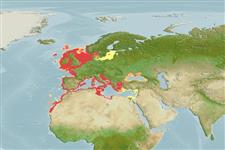Пластиножаберные (акулы и скаты) (sharks and rays) >
Squatiniformes (Angel sharks) >
Squatinidae (Angel sharks)
Etymology: Squatina: Latin for skate, which angel sharks superficially resemble, presumably tautonymous with Squalus squatina Linnaeus 1758 (no species mentioned). (See ETYFish); squatina: Latin for skate, which angel sharks superficially resemble. (See ETYFish).
More on author: Linnaeus.
Environment: milieu / climate zone / depth range / distribution range
экология
морской; солоноватоводный демерсальный; мигрирует в океане (Ref. 51243); пределы глубины 5 - 150 m (Ref. 247). Temperate; 63°N - 21°N, 19°W - 42°E
Northeast Atlantic: southern Norway, Sweden and Shetland Islands to Morocco and West Sahara, including the Canary Islands, the Mediterranean and the Black Sea (Ref. 247). Range and abundance declining 1severely throughout its range; proposed legal protection in Britain (Ref.58085). The European Council Regulations 43/2009, 23/2010, 57/2011, 44/2012, 40/2013, 43/2014, 2015/104 and 2016/72 prohibit to fish for, to retain on board, to tranship and to land the S. squatina in all waters from the European Community (F. Osaer, pers.comm. 04/2016).
Length at first maturity / Size / Вес / Возраст
Maturity: Lm 147.5, range 102 - 169 cm
Max length : 183 cm TL самец/пол неопределен; (Ref. 247); 244.0 cm TL (female); common length : 150 cm TL самец/пол неопределен; (Ref. ); наибольший вес (опубликованные данные): 80.0 kg (Ref. 35388)
Краткое описание
морфология | морфометрия
колючие лучи спинного плавника (общее число): 0; членистые (мягкие) лучи спинного плавника (общее число): 0. Broad flattened body, with enlarged pectoral and pelvic fins, no anal fin. Eyes and large spiracles dorsally. Gill openings at the sides of the head. The mouth is terminal. Coloration variable, from grey to reddish or greenish-brown with scattered small white spots and blackish dots dorsally (Ref. 78469). No ocelli on body (Ref. 247).
A benthic species that occurs inshore, on coasts and along the continental shelf; may enter estuaries (Ref. 247, 58085). Found mainly on sand or mud bottoms; sluggish by day, lying buried with eyes protruding. Also utilizes areas with macroalgae, kelp or rocks (Ref. 88920). Nocturnal species, swims off bottom at night. Feeds mainly on flatfishes and other benthic fishes, but also on skates, crustaceans and molluscs, with one record of swallowed cormorant (Ref. 247, 28070). Moves to deeper waters during winter, returning to the shallower depths in the spring (Ref. 88187), moving northwards in summer. Ovoviviparous (Ref. 50449, 107715). Females generally grow larger than males (Ref. 58137, 107710, 107713, 107715). Detects weak electric fields generated by other organisms (e.g. potential prey) (Ref. 10311). The marine leech Stibarobdella macrothela is a common parasite (Ref. 107712) and the isopod Aegapheles deshaysiana a common micropredator (Ref. 107714) for this shark species in the Canary Islands. Utilized fresh and dried salted for human consumption, and possibly for oil and fishmeal (Ref. 247). Reaches 250 cm (Ref. 35388).
Ovoviviparous, produce 7-25 pups/litter (Ref. 58085), 13.0 +/- 1.9 pups in the Canary Is (Ref. 107713) with litter number increasing with female size. Gestation period lasts for 8-10 months (born Dec-Feb in Mediterranean, July in England) (Ref. 58085), and +/- 6 months in the Canary Is (Ref. 107713). Size at birth ranges from 24-30 cm TL (Ref. 58085). Embryos feed solely on yolk (Ref. 50449). Full term embryos weighed 189-200 g; no egg capsules found around ova or embryos (Ref. 107715). A biannual reproductive cycle is likely the case for this species (Ref. 32746), triannual cycle in the Canary Is (Ref. 107713).
Compagno, L.J.V., 1984. FAO Species Catalogue. Vol. 4. Sharks of the world. An annotated and illustrated catalogue of shark species known to date. Part 1 - Hexanchiformes to Lamniformes. FAO Fish. Synop. 125(4/1):1-249. Rome, FAO. (Ref. 247)
Статус Красного Списка МСОП (Ref. 130435)
Угроза для людей
Traumatogenic
Использование человеком
рыболовство: не имеет хозяйственного значения; объект спортивного рыболовства: да
дополнительная информация
ссылкиаквакультура (рыбоводство)особенности рыбоводствастепень растяжениягенетикаElectrophoresesнаследуемостьболезниобработкаNutrientsMass conversion
инструменты
Специальные отчеты
Скачать в формате XML
ресурсы в Интернет
Estimates based on models
Preferred temperature (Ref.
123201): 7.7 - 19.4, mean 11.4 °C (based on 854 cells).
Phylogenetic diversity index (Ref.
82804): PD
50 = 0.5000 [Uniqueness, from 0.5 = low to 2.0 = high].
Bayesian length-weight: a=0.00832 (0.00428 - 0.01615), b=3.05 (2.88 - 3.22), in cm total length, based on LWR estimates for this species & Genus-body shape (Ref.
93245).
Trophic level (Ref.
69278): 4.1 ±0.5 se; based on diet studies.
устойчивость к внешним воздействиям (Ref.
120179): низкий, минимальное время удвоения популяции 4.5-14 лет (Fec=9-20).
Prior r = 0.27, 95% CL = 0.16 - 0.47, Based on 1 stock assessment.
Fishing Vulnerability (Ref.
59153): Very high vulnerability (90 of 100).
Climate Vulnerability (Ref.
125649): Moderate vulnerability (40 of 100).
Nutrients (Ref.
124155): Calcium = 3.58 [0.60, 65.38] mg/100g; Iron = 0.23 [0.02, 2.63] mg/100g; Protein = 18.2 [16.1, 20.5] %; Omega3 = 0.464 [0.160, 1.307] g/100g; Selenium = 12.7 [2.6, 61.3] μg/100g; VitaminA = 6.41 [0.58, 72.79] μg/100g; Zinc = 0.324 [0.023, 3.530] mg/100g (wet weight);
